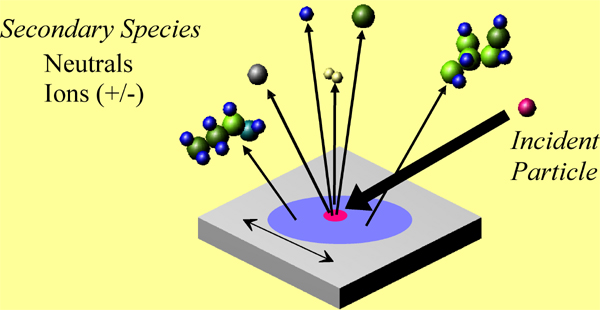Surface Chemistry Studies with Ion Beams and Lasers
This work describes a long term research program aimed toward understanding the fundamental aspects of the interaction of energetic particles with solids and toward developing novel applications using these beams in a variety of surface chemistry studies. Results from this research should find widespread application in such diverse fields as mass spectrometry, polymer science, astrophysics, drug discovery, geology and chemical imaging.
With previous NSF funding, a detailed picture of the collision cascade and of ejected components produced by the incident particle has been developed for organic thin films and molecular solids. The focus of this new initiative is to elucidate new rules for analysis using cluster ion bombardment, particularly with C60 projectiles.
This goal is important since remarkable new properties have emerged that are associated with these projectiles including enhanced sensitivity to higher molecular weight molecules, reduced topography and reduced chemical damage accumulation during ion beam etching experiments. The line of attack is to begin with a well-defined model system that can be prepared reproducibly in the lab such as aromatic molecules adsorbed onto a silver crystal. Then, trajectory information is obtained on the desorbed molecules and compared to advanced molecular dynamics computer simulations of the cluster bombardment event. If there is agreement between experiment and model, then the basic mechanisms of molecular ejection may be inferred. The present hypothesis is that new physical properties arise as a consequence of the mesoscopic nature of the energy dissipation process.
The interaction of cluster ion beams with molecular solids opens new modalities for surface and interface characterization. Of special interest is the development of molecular depth profiling experiments. In this situation, the layers of a molecular solid are removed by the cluster source without the significant accumulation of chemical damage observed with atomic ion sources. A simple model will be developed to elucidate the parameters that give rise to successful profiles and will be tested using thin films of peptide-doped trehalose glass or amorphous ice deposited on a metallic substrate. Cluster ion sources are now amenable to molecule-specific imaging experiments with sub-micron lateral resolution. Development of novel applications of this unique tool continue to be a focus of the research. Significant effort will be employed to combine depth profiling with imaging to provide 3-dimensional analysis of materials with complex molecular architectures.

